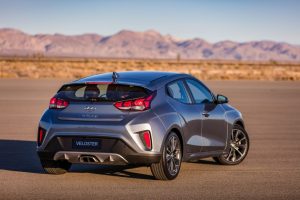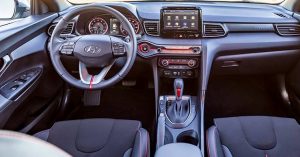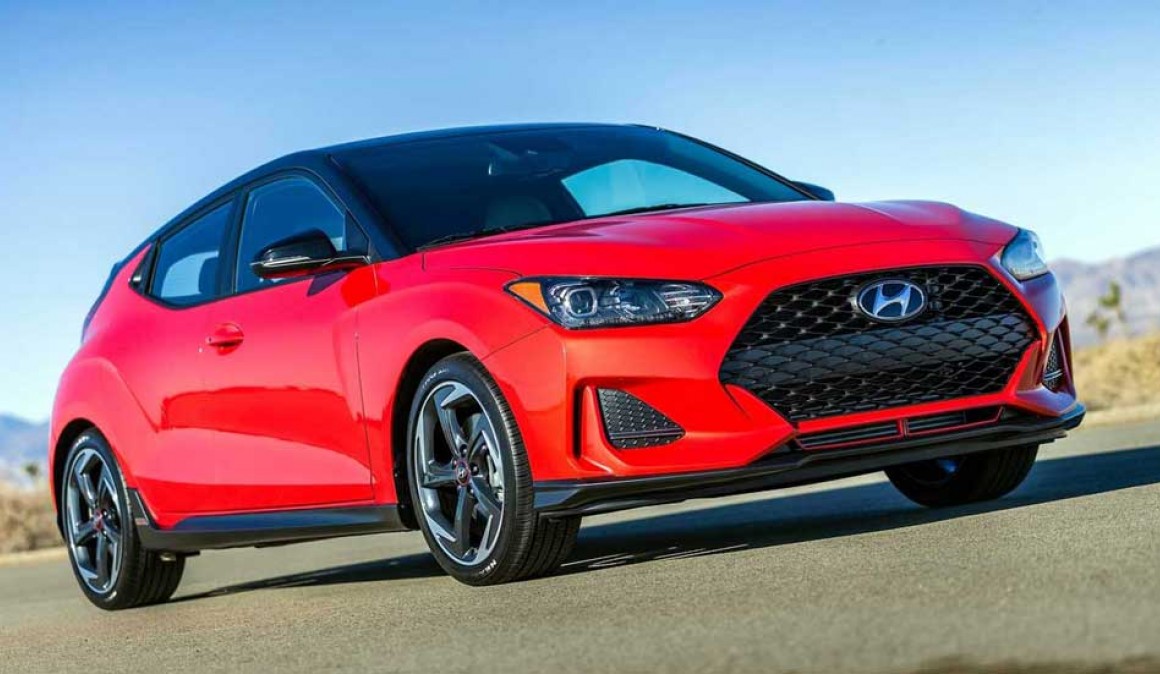By Shari Prymak
The original Hyundai Veloster filled an interesting niche serving as a kind of reverse halo car for the bottom end of the Hyundai lineup. It was developed to spark interest and attract a younger generation of budget-conscious buyers to the Hyundai brand. Its attention-grabbing objective helps explain the oddball styling. Where most entry-level cars are dull and uninspired, the Veloster is eye-catching, bold, and even a little bit weird.
If that’s how Veloster fans like it, then they should be quite satisfied with the model’s 2019 makeover. The overall design really isn’t much of a departure from the original Veloster. It maintains its quirky shape with the drooping roofline, aggressive front and rear fascias, and central exhaust pipes. It also retains its weird asymmetrical three-door design with two doors on the passenger side and only one on the driver side. The cleaner look with toned-down details help to modernize the model while also broadening its appeal. Interestingly, the colour palette includes a few two-tone choices as well as one matte finish, which is an exceedingly rare option in this class.

In keeping with the sporty theme, the Veloster uses a driver-focused instrument panel which makes use of contrasting colours and quality materials throughout the interior. The available leather sport seats are nicely bolstered and well-suited to spirited driving. The backseats, however, are rather tight, and the one-sided rear door does create challenges in certain conditions. As in other Hyundai products, the touchscreen is clear, easy to use, and allows for both Apple CarPlay and Android Auto integration. Below the screen are user-friendly buttons and knobs for common audio and climate control functions.
The Veloster offers a range of drivetrains, and our test drive was spent with the available 1.6L turbocharged engine. Producing 201 horsepower and 195 lb-ft of torque, and matched to either a 6-speed manual or optioned 7-speed dual-clutch transmission, the turbo offers a respectable amount of performance to help match the sporty outward appearance. Turbo Tech models include a powertrain sound enhancer to help add a bit more character, however, I still found the sound to be too tame for my taste. For those sold on the looks but can do without the performance, the entry-level models comes equipped with a 147 horsepower naturally-aspirated 2.0L engine paired to either a 6-speed manual or 6-speed automatic transmission.
All Veloster models come equipped with multi-link independent suspension as well as Torque Vectoring Control (TVC) to help aid with handling and cornering performance. The TVC system, similar to what you would find on higher-priced performance cars, works by pulsing the brakes on the inside wheel while entering a corner, helping to improve grip and stability. Through a challenging pylon course set up for our drive, the Veloster felt surprisingly agile and planted. Push it too hard, however, and understeer quickly begins to take over. The Performance Package is a must-have for these situations, which includes sharp-looking 18 inch wheels wrapped in sticky Michelin Pilot 4 summer-performance tires.

The Veloster lineup starts at $20,999 with the 2.0L engine and $25,899 for the Turbo model. Standard equipment includes heated seats and steering wheel, blind spot monitoring, a 7 inch touchscreen, and, on the Turbo model, LED headlights plus an extra-wide sunroof. The Turbo Tech model starts at $28,899 and includes leather seating, a head-up display, wireless smartphone charging, 8-speaker Infinity sound system, and a larger 8 inch touchscreen with navigation. The DCT or automatic transmission add $1,500 to any trim and the Performance Package can be added to the Turbo and Turbo Tech models for another $500.
Next to comparably-priced hatchbacks as well as Hyundai’s own Elantra GT, the Veloster is a bit of a tough sell from a pure value perspective. The traditional hatchback options have more to offer when it comes to practicality and value for money, while more or less matching the performance. The decision to go with the Veloster ultimately comes down to whether or not you are a fan of the styling and prioritize a fun driving experience. If the goal is to stand out and have a little fun behind the wheel on a budget, the Veloster fits the bill. Just be sure to try the Elantra GT before making a final decision.

